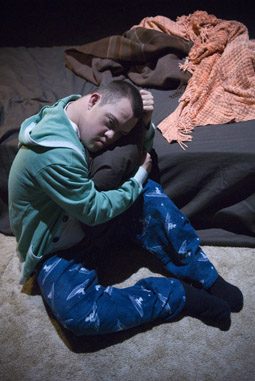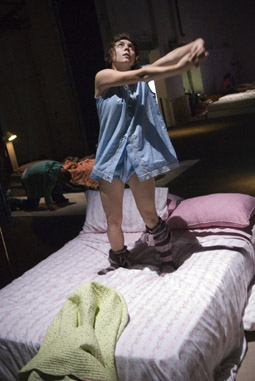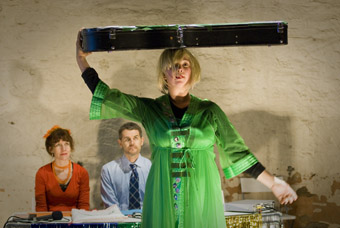comeout 09: artful reciprocity
jonathan bollen: restless dance theatre, unreasonable adults

Andrew Pandos, Bedroom Dancing, Restless Dance Theatre
photo David Wilson
Andrew Pandos, Bedroom Dancing, Restless Dance Theatre
THE INTIMATE PRIVACY OF THE BEDROOM MAKES IT AN APPEALING—YET SOMEHOW DISARMING, EVEN UNSETTLING—SUBJECT FOR SPECTACLE. THE APPEALS OF EXPOSURE AND INSIGHT ARE GENUINE, BUT THE SENSE OF INTRUSION IS DIFFICULT TO SHAKE. BEDROOM DANCING FROM RESTLESS DANCE THEATRE EXHIBITED THE CONTENTS AND OCCUPANTS OF 15 BEDROOMS IN ADELAIDE’S GUTTED QUEEN’S THEATRE.
In the foyer, a video-installation from Lachlan Tetlow-Stuart invited spectators into bed with the cast. Spectators could snuggle up to a pillow and listen to sweet whispers from a speaker concealed within, while video projections of the performers one-by-one sprawled and rolled their way across the vertically-mounted double mattress. Inside the space, the audience were welcome to walk through and watch as bedroom scenes on adolescent themes were played out.
Evenly dispersed on squares of carpet—like booths in an exhibition hall, the beds were single and, for the most part, solitary. Their occupants were preoccupied with various choreographic tasks. Sleeping—even pretending to sleep—did not figure prominently in the work. Rather, the bedrooms were personal zones of retreat, their occupants engaged in world-making and connecting at a distance, communing with objects and media projections of stylised selves.
The mattresses and bedspreads—those soft, intimate technologies of comfort, warmth and enclosure—were, for the most part, misused and displaced. In one room, the bed itself was upended, the bed clothes spilling out in a twisted mess. In another upset gesture, the mattress became a trampoline in defiant memory of however many times a parent told us not to jump on the bed.

Kyra Kimpton, Bedroom Dancing, Restless Dance Theatre
photo David Wilson
Kyra Kimpton, Bedroom Dancing, Restless Dance Theatre
At an audio installation in the middle of the exhibit, one performer explained that “dancing in the bedroom is not what I usually do.” What distinguished each bedroom were the activities and technologies—some old, some new—of play and escape: a pair of dice, a jigsaw, some toy soldiers, a ukulele, a torch and a book, pencils and paper, travel magazines, a CD player, a radio, a laptop with Skype video-conferencing.
As a piece of dance theatre, Bedroom Dancing was a large-scale assemblage—a collaboration between 15 performers of the Restless Youth Ensemble and an artistic team comprising director Steve Mayhew, choreographer Alison Currie, designer Gaelle Mellis, sound artist Jason Sweeney and lighting designer Ben Shaw. It was also a project for a company in transition, initiated by outgoing artistic director Ingrid Voorendt and staged as incomer Philip Channells took up the role.
Presented as part of Come Out 2009, the Australian arts festival for young people, Bedroom Dancing attracted strong audiences over the course of a week. There were almost too many spectators at the performance I attended. Walking amongst the bedrooms and the crowd entailed an up-close relation of looking down at the performers’ work, which tended to individualise and isolate each bedroom as an exhibit in itself.
Instead of wandering from exhibit to exhibit, I found myself wanting to get down low and look across—to see and sense connections and relations across the array of bedrooms. But opportunities for a wide-angled, zoomed-out focus were difficult to grasp, until, cued by Sweeney’s sound work, the performance climaxed in a communal shudder.
Occasionally during the performance, some dancers visited each other’s bedrooms where they danced together for a while. These were welcome moments because they enacted a desire for contact to cut across the cell-like isolation of the exhibits. Prompted by memories of the adolescent loneliness evoked in this work, I felt a desire for more of these moments of connection across bedrooms.
Contact and connection are the hallmarks of Unreasonable Adults’ successful Gift/Back series. In its latest incarnation as part of Come Out, Unreasonable Adults invited young people to participate in the gift-exchange of supplying raw materials with which the artists make art. The artists called for gifts of a virtual, mediated or actual kind. Kids donated photos, drawings and paintings of themselves and their worlds. They also donated dolls, bears and cartoon characters, popsicle puppets, a clock, a billy cart and a large bag of rice, the names of some colours and some scraps of text. The artists’ undertaking was to use and respond to all they received.
The resulting mix-and-match process yields outcomes both inherently surreal and intimately connected to their audience. As an avant-garde approach to the making of art, the Gift/Back technique seems uncannily suited to a young audience. In creating opportunities for contribution, participation and recognition, it also models an artful ethic of re-use, re-cycling and re-invention which merits emulation.

Julie Vulcan, Jason Sweeney, Kerrin Rowlands, Gift/Back, Unreasonable Adults
photo Sam Oster
Julie Vulcan, Jason Sweeney, Kerrin Rowlands, Gift/Back, Unreasonable Adults
At the performance I attended, the audience sat—cross-legged, of course—on squares of carpet in the Queen Theatre’s second space. We were addressed by the performers directly. The structural clarity of the work—with its step-by-step articulation of segments and an hilarious half-time break for orange slices and odour-ama—revealed an almost educational aptitude for engaging the audience in a process of aesthetic elaboration. I was taken by the work.
The look was colourful and bright. Three performers—Julie Vulcan dressed in orange, Kerrin Rowlands in green and Jason Sweeney in blue—performed a series of meditations on the value of colour in our world. Caroline Daish appeared remotely as an animated face. The set was as vibrant as children’s television. The mood was lively and engaging, the themes just slightly sinister.
Vulcan, addressing the audience in story-book mode, invites us to consider a world in which the colours orange, green and blue are replaced wherever they appear with dismal shades of grey. With excess affect, Rowlands dances in an apple-green negligee with a guitar case, the contents of which remain unrevealed. Intimate on live video, Sweeney tells a stick puppet story of lost children and croons a medley of blue tunes.
The work was intriguing, visually delightful and gently subversive with its imaginative narratives of abnegation and loss. The pleasures for an audience of young adults at the evening performance were apparent. The performers seemed ready to entertain, freshened perhaps by the afternoon performance to an audience of parents and children.
I attended the evening performance so I can’t say how the work played to children. But if I had taken a child or two I would have been grateful for their opportunity to participate in the artful reciprocity of Unreasonable Adult’s Gift/Back.
Come Out 2009: Restless Dance Theatre, Bedroom Dancing, devised and performed by the Restless Youth Ensemble, director Steve Mayhew, choreographer Alison Currie, design Gaelle Mellis, sound Jason Sweeney, lighting Ben Shaw; Queen’s Theatre, May 15-22; Unreasonable Adults, Gift/Back, Caroline Daish, Kerrin Rowlands, Fiona Sprott, Jason Sweeney, Julie Vulcan, Queen’s Theatre, Adelaide, May 29, 30
RealTime issue #92 Aug-Sept 2009 pg. 45






